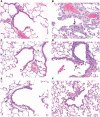Editor's Highlight: Complete Attenuation of Mouse Lung Cell Proliferation and Tumorigenicity in CYP2F2 Knockout and CYP2F1 Humanized Mice Exposed to Inhaled Styrene for up to 2 Years Supports a Lack of Human Relevance
- PMID: 28962520
- PMCID: PMC5837194
- DOI: 10.1093/toxsci/kfx141
Editor's Highlight: Complete Attenuation of Mouse Lung Cell Proliferation and Tumorigenicity in CYP2F2 Knockout and CYP2F1 Humanized Mice Exposed to Inhaled Styrene for up to 2 Years Supports a Lack of Human Relevance
Abstract
Styrene is a mouse-specific lung carcinogen, and short-term mode of action studies have demonstrated that cytotoxicity and/or cell proliferation, and genomic changes are dependent on CYP2F2 metabolism. The current study examined histopathology, cell proliferation, and genomic changes in CD-1, C57BL/6 (WT), CYP2F2(-/-) (KO), and CYP2F2(-/-) (CYP2F1, 2B6, 2A13-transgene) (TG; humanized) mice following exposure for up to 104 weeks to 0- or 120-ppm styrene vapor. Five mice per treatment group were sacrificed at 1, 26, 52, and 78 weeks. Additional 50 mice per treatment group were followed until death or 104 weeks of exposure. Cytotoxicity was present in the terminal bronchioles of some CD-1 and WT mice exposed to styrene, but not in KO or TG mice. Hyperplasia in the terminal bronchioles was present in CD-1 and WT mice exposed to styrene, but not in KO or TG mice. Increased cell proliferation, measured by KI-67 staining, occurred in CD-1 and WT mice exposed to styrene for 1 week, but not after 26, 52, or 78 weeks, nor in KO or TG mice. Styrene increased the incidence of bronchioloalveolar adenomas and carcinomas in CD-1 mice. No increase in lung tumors was found in WT despite clear evidence of lung toxicity, or, KO or TG mice. The absence of preneoplastic lesions and tumorigenicity in KO and TG mice indicates that mouse-specific CYP2F2 metabolism is responsible for both the short-term and chronic toxicity and tumorigenicity of styrene, and activation of styrene by CYP2F2 is a rodent MOA that is neither quantitatively or qualitatively relevant to humans.
Keywords: CYP2F1 humanized mice; CYP2F2-knockout mice; chronic study; proliferative lesions; styrene.
© The Author 2017. Published by Oxford University Press on behalf of the Society of Toxicology. All rights reserved. For Permissions, please e-mail: journals.permissions@oup.com.
Figures



References
-
- Carlson G. P. (1997). Effects of inducers and inhibitors on the microsomal metabolism of styrene to styrene oxide in mice. J. Toxicol. Environ. Health 51, 477–488. - PubMed
-
- Carlson G. P. (2004). Comparison of the susceptibility of wild-type and CYP2E1 knockout mice to the hepatotoxic and penumotoxic effects of styrene and styrene oxide. Toxicol. Lett. 150, 335–339. - PubMed
-
- Collins J. J., Bodner K. M., Bus J. S. (2013). Cancer mortality of workers exposed to styrene in the U.S. reinforced plastics and composites industry. Epidemiology 24, 195–203. - PubMed
-
- Cruzan G., Carlson G. P., Johnson K. A., Andrews L. S., Banton M. I., Bevan C., Cushman J. R. (2002). Styrene respiratory tract toxicity and mouse lung tumors are mediated by CYP2F-generated metabolites. Regul. Toxicol. Pharmacol. 35, 308–319. - PubMed
-
- Cruzan G., Carlson G. P., Turner M., Mellert W. (2005). Ring-oxidized metabolites of styrene contribute to styrene-induced Clara-cell toxicity in mice. J. Toxicol. Environ. Health A 68, 229–237. (2005). - PubMed
Publication types
MeSH terms
Substances
LinkOut - more resources
Full Text Sources
Other Literature Sources
Medical
Molecular Biology Databases
Research Materials
Miscellaneous

